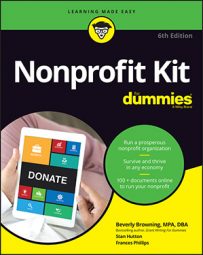It’s also important to examine your personal mission before launching a nonprofit. You’re creating a legal entity that has responsibilities for reporting to both the state and federal governments. If the organization grows to the point where you must hire employees, you’re responsible for paying regular salaries and providing adequate benefits. And although you can be compensated for your work as a nonprofit staff member, you can’t develop equity in the organization or take away any profits at the end of the year.
Setting up a nonprofit
Nearly all nonprofit organizations are established as corporations under the laws of a particular state. If you’re located in Iowa and you plan to do most of your work in that state, you follow the laws in Iowa to set up the basic legal structure of a nonprofit corporation. Although you’ll find some differences from state to state, in general, the process requires writing and submitting articles of incorporation to the state and developing bylaws, the rules under which the corporation will operate.After your nonprofit is established under your state laws, the next step is applying for 501(c)(3) status from the IRS. This step requires completing and submitting IRS Form 1023 or Form 1023-EZ. If you submit Form 1023, you will need to specify in some detail the proposed activities of the new organization, and you’re asked for projected revenue and expenses for the year in which you apply and two years into the future.
You can’t complete this form in one afternoon. It requires substantial time and thought to develop the necessary material and should be reviewed by an accountant and legal representative before filing.
Making plans and being flexible
After you start managing a nonprofit organization, you’ll discover that planning is your best friend. Every task from budgeting to grant writing requires that you make plans for the future. And you need to do a substantial amount of planning before you’re ready to send in your IRS application for tax exemption.Don’t be frightened by this recommendation to plan. The act of planning fundamentally comes down to thinking through what you’re going to do as well as how and when you’re going to do it. Your plan becomes the map that guides you toward achieving your goals and your nonprofit mission. Planning is something that you should pay attention to every day.
You should always begin with a plan, but that doesn’t mean that plans shouldn’t be altered when the situation calls for it. Circumstances change; flexibility and adaptability are good traits to nurture if you’re running a nonprofit organization.
The nonprofit world is bigger than a breadbox
The nonprofit sector is larger than many people realize. Here are some figures from the National Center for Charitable Statistics, based on IRS data, and the Independent Sector, regarding 501(c)(3) public charities in the United States:- Nearly 1.2 million organizations were registered as public charities with the IRS in 2015.
- Assets held by these groups in 2013 totaled more than $3 trillion.
- The number of public charities increased by nearly 23 percent between 2008 and 2015.
- Nearly 30 percent of public charities that reported to the IRS in 2012 had annual expenses of less than $100,000.

